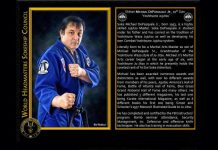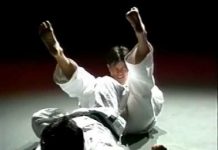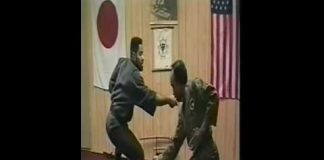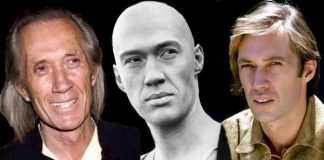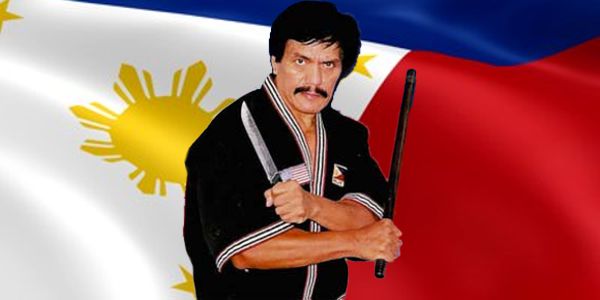 KSW. Just to get a better understanding of your foundation, let’s touch briefly on your physical education training and how that led to you becoming Mr. Philippines through bodybuilding?
KSW. Just to get a better understanding of your foundation, let’s touch briefly on your physical education training and how that led to you becoming Mr. Philippines through bodybuilding?
R.D. Yes, bodybuilding came to me almost like an accident because I was actually playing high school basketball at that time and had an injury to my right knee from falling. The rehabilitation program I was brought into introduced me to the weight training, which led to bodybuilding. When I started getting results I dedicated myself totally (laughs) pretty soon I was competing. Fortunately, I met one gentleman who was instrumental in bodybuilding, Mr. Pedador (need spelling). I think he lives in San Francisco now. Mr. Pedador programmed my workouts and I entered my first competition and won the National Mr. Novice. This event was just for beginners of bodybuilding. Winning that event inspired me to push myself all the way.
KSW. Thank you that’s an exhilarating step for a young man’s future. Roland, theirs is no question how beneficial and dynamic weight training is, when did things really start to happen for you as a professional bodybuilder?
R.D. Well (laughter), my first time to win the Mr. Philippine’s title was in 1969. Part of that prize responsibility was to represent the Philippines in the Mr. Universe Contest. At that time, the Mr. Universe Contest took place in New York City. Mr. Universe comprises all the contestants from different countries. This 1969 was the year Arnold Schwarzenegger won and he represented Austria. As a representative of the Philippines I became the fourth runner up in the Mr. Universe Contest.
KSW. Through the competitive arena, Arnold and you became friends. Could you share a little insight into that friendship with our readers?
R.D. Strange things seem to happen for different reasons Datu Kelly. Sometimes I hear negative comments about Arnold and I get a little upset because I don’t think most people know the true personality of Arnold. Arnold is a very nice guy, a true gentleman. Because when I first met him he only knew a few words of English. Arnold really pushed himself learning more about conversational English attended college to further his communication skills and look what happened, in no time he reached his goal. Anyway, after Mr. Universe, I stayed here in the United States as a working student. I was enrolled at the University of Maryland and was taking more physical education courses and working part time as a gym instructor in a fitness studio in Baltimore. This was a chain of studios that branched out all the way to Florida. At that time, I didn’t know Arnold stayed in the United States too. By coincidence, Arnold worked with the same company I was working with. A year after the Mr. Universe Contest in 1970, we bumped into each other. I didn’t know he was hired by the same fitness studio. One day I reported to work and a huge crowd was forming outside of the fitness center. I thought there was a fire or something.. And said what’s going on? Someone replied, “Mr. Universe is here and he is working out.” I went inside and immediately Arnold recognized me, yelled out and waved his hand. “I remember you, you are Mr. Philippines,” and Arnold gave me a big hug surprising everyone, including me. After he finished his set, I was approached by so many people wanting pictures and autographs with him, I whispered in his ear asking him if he had time. Arnold replied, “No problem.” Went straight to the ladies, gave one a hug and kiss and said, “Come on let’s take some pictures.” Everyone was just shocked (laughing) Straight away the personality of the man and his charisma shined through. That’s the way he was even before he was a movie star.
KSW. Kind of like hanging with Elvis. That’s cool Roland, thank you for sharing those memories. Well, Roland, you are quite famous and well know also. Not only in the Philippines but also worldwide. Martial arts and bodybuilding opened the doors for your movie career.
Well, humble as you are, you are essentially the Arnold Schwarzenegger of the Philippines and quite famous in your own right. I have enjoyed your movies for years and shared those films with my friends and students.
You have been instrumental in giving the Philippine Martial Arts a lot of exposure worldwide incorporating the Art in your action adventure movies. You include not only training and fighting sequences but the historical significance and cultural connection Arnis has with the people of the Philippines. Please share a bit about that history.
R.D. Thank you very much, I feel honored by your statements Datu … I owe a lot first and foremost again to Professor Presas. It was actually Pacific Connection that broke me into the movie world and started my career. Because of the success of Pacific Connection with me playing the lead with Hollywood stars like Nancy Kwan, Guy Madison, Dean Stockwell and the Japanese Samurai actor Hiroshi Tanaka, who also starred with Charles Bronson in the American Western Classic “The Red Sun.” That initial exposure gave me the break I needed to become established in the movies. Sometime after the Mr. Universe Contest, I returned to the Philippines and was a guest on a television talk show. A movie producer approached me after the show and offered me the role. I didn’t even know I was going to play the lead role I was just excited to be asked. When I found out the movie was about the Filipino Martial Arts and Arnis to be featured in the film, straight away it must have been destiny because I was then a student of the Professor (Presas). It coincided that I knew the Art because of the Professor and right away we worked close together as the Professor choreographed the beautiful fight scenes, Arnis verses the Samurai. With due respect, of course, to the Japanese martial arts, the Professor Presas choreographed the fight scenes in a way that we never put down or plays down. The Japanese art in the fight scenes it played on even lead just to give the respect, so to speak. The Pacific Connection was beautifully choreographed and the success of that movie led to the follow up movie, Sticks of Death. After the movie, many Hollywood producers and actors realized the beauty and value of the Filipino Martial Arts and included the Philippine Martial Arts in their armed and unarmed combat scenes. In fact, Steven Segal’s empty hand, a lot of his moves come from the Mano y mano techniques of the Filipino Martial Arts. I worked with Chuck Norris in Delta Force II. The film was shot in the Philippines. They even consented to my proposal that they include the Balisong with Chuck Norris fighting the bad guy, actor attacking him with the Filipino knife Balisong, the Fan Knife, the Butterfly Knife.
KSW. Thank you, Roland. Roland, could you discuss the meeting you had with Dan Inosanto.
R.D. Yes, I first met Dan in 1975, Professor Presas and I were invited to his school in Torrence, California. Hollywood actor Dean Stockwell drove us to the training center. When we arrived a class was in attendance and Richard Bustillo was beating the drums for rhythm, it was a very impressive class. After the training session ended, Dan asked the Professor to give a demonstration. Dean Stockwell and I assisted in the Arnis presentation. Following the demo, Dan’s students purchased copies of Professor’s book and rattan sticks brought in from the Philippines. It was indeed a very eventful meeting enjoyed by everyone in attendance. Several years later in 1981, I believe, on the island of Kuai, in Hawaii, I had been invited by the Filipino Arnis Committee to show my film, “Sticks of Death” for a fundraiser. They approached me in the Philippines to participate in a cultural event so I brought Arnis Sticks of Death for a special showing in Hawaii, first Honolulu, then Kuai. I was surprised when I got to the island, it was public holiday. The governor, George Archosi, had declared it a special holiday in honor of Grandmaster Floro Villabrille, who lived in Hawaii for many years. A big event was scheduled to celebrate the Kali Grandmaster. The premier showing of “Arnis, Sticks of Death,” and the celebration event just so happened to be scheduled for the same evening. A very exciting time for Philippine Martial Arts. A very dynamic demonstration in honor of Grandmaster Villabrille was presented. Master Ben Lagasa, Greg Lantayao, Lucky Lucaylucay, Master Bao Bao, Wally Jay and others. So many skilled martial artists together. Imagine a public holiday declared on that island just to honor and celebrate Grandmaster Villabrille, life long commitment to the Philippines Martial Arts of Escrima and Arnis.
KSW. Dean Stockwell became involved in Arnis mainly for the movie Pacific Connection. Did Dean continue his training after the movie?
R.D. Yes, Dean and I worked together on that movie project, Professor Presas was selected as the technical consultant for the fight scenes and additionally trained Dean Stockwell, Guy Madison and Alehandro Reyes in the Philippine Martial Arts. Dean got so enthused with Arnis that his training embraced the complete Modern Arnis curriculum. Dean studied long and hard at Arnis. Several years after the movie when I came to the United States I met with Dean and he had a group of Arnisadors all training at his home in the Hollywood Hills. I believe it was 1981 in Tapanga Canyon. Dean shared his knowledge with quite a few other actors including Jack Nicholson whom he was close friends with. Dean was filming a TV series or movie he wasn’t shy, he was very dedicated to Arnis and let it be known that he loved the art.
KSW. That’s pretty cool. Roland, maybe you could expound on the state of the art here in America?
R.D. Yes, yes. I would have to say it’s incredible that’s the word I would use to describe the explosion of Philippine Martial Arts over the years. The acceptance of Arnis, Kali, Escrima and the Philippine Martial Arts which interconnects any martial arts discipline has become a reality to the martial artists here in the United States, as well as Canada, Europe and worldwide. I would like to commend all the propagator of Filipino Martial Arts for their hard work and personal efforts. Additionally, my personal respects to you, Datu Kelly Worden, because you’ve accomplished so much in terms of incorporating the flow, and following through with what Professor Presas refers to as the “Art within your Art.” Just watching you instruct I can see you’ve interconnected so many concepts from one discipline to another. Your methodology beautifully flows from weaponry to empty hand and vice versa. I honor you for your convictions, it is no wonder Professor entrusted you with the coveted title of Datu because you deserve it. As Professor recently confided to me personally, you are the most dynamic and creative of all his Modern Arnis students and senior of the very few he has promoted to Datu in his many years of teaching, a true honor I attest to.
KSW. Roland, a close friend and martial arts brother of ours was recently promoted to the status of Datu. What can you tell us about Halford Jones?
R.D. Yes, Halford has been a long time resident of the Philippines. He is married to a Filipino. Halford has dedicated an enormous amount of years to training and researching the Philippine Martial Arts. I believe it was Grandmaster Porfilio Lanada that recognized Halford Jones for his contribution for what he has done for the Lanada system and Philippine martial arts in general. Grandmaster Lanada is a very good friend of mine and I spent time with him last year. He is recovering very well. As the Filipino martial arts world knows, Grandmaster Lanada unfortunately suffered a stroke about two years ago, I am happy to say I spoke with him last year and he is recovering well.
KSW. Since we are talking about close friends, I’m excited to inform you that Christopher Ricketts was here in the United States and spent time teaching on the west coast. Sgt. Kevin Underwood arranged for his visit and I was more than happy to offer him a couple days with my military group of soldiers at Fort Lewis, Washington. He trained mostly Espada Daggar and we had a great time. Of course, it is good for the military to experience the value of cross training in different styles. Christopher Ricketts is a very dynamic instructor and also a very close friend of the late Edgar Sulite. If I remember correctly in our past conversations, Edgar Sulite was also a close friend of your’s while you were both in the Philippines. It seems like such a small world sometimes since we have all come together recently. I was totally excited to have Christopher Ricketts to come through, as one of the inheritors of the Kali Illistrimo System, he has much to share, as well as Tony Diego, Christopher’s senior in the system. Edgar Sulite was great practitioner and he is missed dearly by the Filipino martial arts community. I know you were instrumental in assisting him in his efforts to spread his art. Additionally, Thopher presented me with one of Edgar’s knives and his first book in which a picture of your wife and you were in. Can you share a little about Thopher and Edgar?
R.D. Thank you again Datu Kelly, Thopher Ricketts was one of the stalwarts of the KAFAHIL, which is the Karate Federation of the Philippines. In his younger days, I call him younger because I am much older than him. I will put it that way (laughter). He was under the direct guidance of the late Dr. Gilarimo Lengson. KAFAPHIL is the Filipino style we call it that way because it incorporated additional techniques not traditionally Okinawa or Goju karate. He did this in such a way he could not call it traditional karate such as the JKA, Japanese Karate Association, mainly because JKA had set standards and Dr. Lengson modified traditional karate into a Filipino style of its own. Dr. Lengston was a compadre of Professor Presas along with another Grandmaster Johnny Chutan; they were very close. Together they worked in establishing a combination of styles. So, Thopher was one student I noticed in those years that was very good in his techniques and forms. At that time, I was hosting a martial arts show. In fact, it was the first one on national TV, very successful. We lasted for about 3 1/2 years. I was sports casting for that show on three different channels. We were the first one’s to put up live, full contact karate martial arts shows on television in the Philippines. It was an afternoon program on the weekends and we had very good ratings. At that time we had the U.S. Air Force, Clark Air Base, so the Air Force guys would come over and fight full contact with the gloves and safety equipment. Some of them even competed in the first Arnis competition. We had one competition because the show sponsors didn’t know about Philippine Martial Arts. That’s the sad part of it, right in the Philippines, the Philippine Martial Arts unfortunately should I say, did not have much support then, you know like other martial arts. To get the program it was then called Karate-Arnis Filipino that was the name of the show, “Karate-Arnis Filipino” that means “Karate in the Filipino-way and Arnis.”
So we had full contact competitions and Thopher was one of the competitors regularly. We had weekly champions and monthly champions. As competition progressed each monthly champion would fight in the finalization of the show to establish the champion of the year. If I am correct in my memory, Thopher reached the finals one year, but that was how I remember Thopher years ago. Those were exciting times in my career so long ago. Thopher was quite close tot he KAFAPHIL Group. My younger brother actually was more senior to him because he was with the Master Johnny Chuiten and Dr. Lengston as well. I would like to invite him here to the United States when he has time. He is an airlines pilot right now and travels all around the world. He flies for Saudi Air but he is a martial artist too and knows Thopher very well. My wife and I in fact were invited to Thopher’s wedding in the Philippines. He has done very well and has accomplished a lot for the Philippine Martial Arts I have to commend Thopher for that.
KSW. Let’s talk briefly about Edgar Sulite. Edgar has passed recently and I think people would enjoy hearing how special he was to the arts and about his dynamic impact on the martial arts.
R.D. Yes, he was Datu Kelly, he was a very dynamic martial artist, as a young man, I first met him when he came to Manila. Edgar came from Osami City which is the Mindinnao, the same island that I am from. I had never met him before, but he had seen one of my films. I’m not sure if it was “Pacific Connection” or “Sticks of Death”. He found out where my gym was located, I had a gym at that time with my partner, Rusty Santos. Professor knows him too very well. At that time in Manila, this young man came over and introduced himself and he said he was a practitioner of Arnis. His master was Master Caballara from the south. I said oh, I had heard that name but I never had the chance to meet Master Caballara. I would to have loved to meet him. So straight away Edgar said, “Can I show you our moves?” Of course, I responded I would love to see your art. I had one side of the gym which was like a private training area so it was just him and I. So when I saw him move, I said to myself “This guy is good.” And Edgar said to me, “very good techniques you have.” We got along great and he asked me “Would you mind if I trained here?” “Of course, look, you are welcome to work out here anytime you want to.” Straight away I told him. Because he had just moved here with his family in Passai City, I even drove him home, you know .. and I said, “You come over here (to my gym) and I will get you some private students while you are here working out.” That’s how we got to know each other very well, Edgar shared with me his now world renowned Lameco style. In fact, the year he passed away he contacted me and wanted to have a reunion together. I said I would love to go meet him in the Philippines. I was still in Australia at that time. I was so shocked when I heard about him passing. Thopher contacted me and informed me of the sad night that it happened, all very sudden. I have to commend Edgar for the time he had spent in the United States. When he came here, he was able to propagate his Lameco style, Largo, Medio, Corto. Which is long range, medium range and close quarters that’s what Lameco means. He was able to share this system with other forms of martial arts. Before he left for the United States he called me up and said “I’m doing a book, I’m going to make a book Brother Roland.” I said, don’t forget to mention the other masters too, so I commend him, may he rest in peace. I know he is with God. So, well done Edgar.
KSW. Thank you Roland. This has been Kelly Worden for KLAY Radio “On the Edge” with Roland Dantes, world famous martial artist, former Mr. Philippines Body Builder, great practitioner of the martial arts and close friend of Professor Remy Presas. We will be hearing more from Roland Dantes when we cross reference our interview with Professor Remy Presas. Roland, thank you for joining us today.


